Quantification of the Cooling Effect and Cooling Distance of Urban Green Spaces Based on Their Vegetation Structure and Size as a Basis for Management Tools for Mitigating Urban Climate
Abstract
:1. Introduction
2. Materials and Methods
2.1. Study Area
2.2. Data Sources
2.2.1. Data to Identify Vegetation in the City
2.2.2. Data for Land Surface Temperature Retrieval
2.3. Identification of Vegetation and Land Cover in the City
2.4. Land Surface Temperature Retrieval
2.5. Statistical Analysis of Green Spaces Cooling Effect and Distance of Cooling Effect Analyses
2.5.1. Evaluation of Green Spaces Cooling Intensity
2.5.2. Evaluation of the Green Spaces Cooling Distance
3. Results and Discussion
3.1. Cooling Intensity
3.2. Cooling Distance
3.2.1. Cooling Distance Evaluated by a Simple Regression Analysis
3.2.2. Cooling Distance Evaluated by One-Way Analysis of Variance
4. Conclusions
Supplementary Materials
Author Contributions
Funding
Data Availability Statement
Conflicts of Interest
References
- Pickett, S.T.A.; Cadenasso, M.L.; Grove, J.M.; Nilon, C.H.; Pouyat, R.V.; Zipperer, W.C. Urban ecological systems: Linking terrestrial ecological, physical, and socioeconomic components of metropolitan areas. In Urban Ecology. An International Perspective on the Interaction Between Humans and Nature; Marzluff, J., Shulenberger, E., Endlicher, W., Bradley, G., Simon, U., Alberti, M., Ryan, C., ZumBrunnen, C., Eds.; Springer: New York, NY, USA, 2008; pp. 99–122. [Google Scholar] [CrossRef]
- Oke, T.R.; Mills, R.; Christen, A.; Voogt, J.A. Urban Climates; Cambridge University Press: Cambridge, UK, 2017; p. 519. [Google Scholar] [CrossRef] [Green Version]
- Kuttler, W. The urban climate—Basic and applied aspects. In Urban Ecology. An International Perspective on the Interaction Between Humans and Nature; Marzluff, J., Shulenberger, E., Endlicher, W., Bradley, G., Simon, U., Alberti, M., Ryan, C., ZumBrunnen, C., Eds.; Springer: New York, NY, USA, 2008; pp. 233–248. [Google Scholar] [CrossRef]
- Gartland, L. Heat Islands. Understanding and Mitigating Heat in Urban Areas; Routledge: London, UK, 2008; p. 215. [Google Scholar] [CrossRef]
- Poumadere, M.; Mays, C.; Le Mer, S.; Blong, R. The 2003 heat wave in France: Dangerous climate change here and now. Risk Anal. 2005, 25, 1483–1494. [Google Scholar] [CrossRef]
- Hondula, D.M.; Davis, R.E.; Leisten, M.J.; Saha, M.V.; Veazey, L.M.; Wegner, C.R. 2012: Fine-scale spatial variability of heat-related mortality in Philadelphia county, USA, from 1983-2008: A case-series analysis. Environ. Health 2012, 11, 16. [Google Scholar] [CrossRef] [Green Version]
- Su, M.A.; Ngarambe, J.; Santamouris, M.; Yun, G.Y. Empirical evidence on the impact of urban overheating on building cooling and heating energy consumption. iScience 2021, 24, 102495. [Google Scholar] [CrossRef]
- White, M.A.; Nemani, R.R.; Thornton, P.E.; Running, S.W. Satellite evidence of phenological differences between urbanized and rural areas of the eastern United States deciduous broadleaf forest. Ecosystems 2002, 5, 260–277. [Google Scholar] [CrossRef]
- Irmak, M.A.; Yilmaz, S.; Dursun, D. Effect of different pavements on human thermal comfort conditions. Atmósfera 2017, 30, 355–366. [Google Scholar] [CrossRef] [Green Version]
- Garcia-Nevado, E. Termografía del Cañón Urbano: Uso de la Perspectiva para una Evaluación Térmica Global de la Calle. Ph.D. Thesis, Universitat Politecnica de Catalunya, Barcelona, Spain, 2019; p. 606. [Google Scholar]
- Yezioro, A.; Capeluto, I.G.; Shaviv, E. Design guidelines for appropriate insolation of urban squares. Renew. Energy 2006, 31, 1011–1023. [Google Scholar] [CrossRef]
- Ali-Toudert, F.; Mayer, H. Effects of asymmetry, galleries, overhanging facades and vegetation on thermal comfort in urban street canyons. Sol. Energy 2007, 81, 742–754. [Google Scholar] [CrossRef]
- Hong, C.; Yang, Y.; Ge, S.; Chai, G.; Zhao, P.; Shui, Q.; Gu, Z. Is the design guidance of color and material for urban buildings a good choice in terms of thermal performance? Sustain. Cities Soc. 2022, 83, 103927. [Google Scholar] [CrossRef]
- Susca, T.; Gaffin, S.R.; Dell’Osso, G.R. Positive effects of vegetation: Urban heat island and green roofs. Environ. Pollut. 2011, 159, 2119–2126. [Google Scholar] [CrossRef]
- Lobaccaro, G.; Acero, J.A. Comparative analysis of green actions to improve outdoor thermal comfort inside typical urban street canyons. Urban Clim. 2015, 14, 251–267. [Google Scholar] [CrossRef]
- Aram, F.; García, E.H.; Solgi, E.; Mansournia, S. Urban green space cooling effect in cities. Review article. Heliyon 2019, 5, e01339. [Google Scholar] [CrossRef] [Green Version]
- Zhang, Q.; Zhou, D.; Xu, D.; Rogora, A. Correlation between cooling effect of green space and surrounding urban spatial form: Evidence from 36 urban green spaces. Build. Environ. 2022, 222, 109375. [Google Scholar] [CrossRef]
- Oliveira, S.; Andrade, H.; Vaz, T. The cooling effect of green spaces as a contribution to themitigation of urban heat: A case study in Lisbon. Build. Environ. 2011, 46, 2186–2194. [Google Scholar] [CrossRef]
- Shashua-Bar, L.; Pearlmutter, D.; Erell, E. The cooling efficiency of urban landscape strategies in a hot dry climate. Landsc. Urban Plann. 2009, 92, 179–186. [Google Scholar] [CrossRef]
- Mackey, C.W.; Lee, X.; Smith, R.B. Remotely sensing the cooling effects of city scale efforts to reduce urban heat island. Build. Environ. 2012, 49, 348–358. [Google Scholar] [CrossRef]
- Cao, X.; Onishi, A.; Chen, J.; Imura, H. Quantifying the cool island intensity of urban parks using ASTER and IKONOS data. Landsc. Urban Plann. 2010, 96, 224–231. [Google Scholar] [CrossRef]
- Blachowski, J.; Hajnrych, M. Assessing the cooling effect of four urban parks of different sizes in a temperate continental climate zone: Wroclaw (Poland). Forests 2021, 12, 1136. [Google Scholar] [CrossRef]
- Shashua-Bar, L.; Hoffman, M.E. Vegetation as a climatic component in the design of an urban street. An empirical model for predicting the cooling effect of urban green areas with trees. Energy Build. 2000, 31, 221–235. [Google Scholar] [CrossRef]
- Teixeira, C.F.B. Green space configuration and its impact on human behavior and urban environments. Urban Clim. 2021, 35, 100746. [Google Scholar] [CrossRef]
- Sun, C.Y. A street thermal environment study in summer by the mobile transect technique. Theor. Appl. Climatol. 2011, 106, 433–442. [Google Scholar] [CrossRef]
- Yan, H.; Wu, F.; Dong, L. Influence of a large urban park on the local urban thermal environment. Sci. Total Environ. 2018, 622–623, 882–891. [Google Scholar] [CrossRef] [PubMed]
- Park, J.; Kim, J.H.; Sohn, W.; Lee, D.-K. Urban cooling factors: Do small greenspaces outperform building shade in mitigating urban heat island intensity? Urban For. Urban Green. 2021, 64, 127256. [Google Scholar] [CrossRef]
- Yan, L.; Jia, W.; Zhao, S. The cooling effect of urban green spaces in metacities: A case study of Beijing, China’s capital. Remote Sens. 2021, 13, 4601. [Google Scholar] [CrossRef]
- Nichol, J.E.; Fung, W.Y.; Lam, K.; Wong, M.S. Urban heat island diagnosis using ASTER satellite images and ‘in situ’ air temperature. Atmos. Res. 2009, 94, 276–284. [Google Scholar] [CrossRef]
- Arnfield, A.J. Two decades of urban climate research: A review of turbulence, exchanges of energy and water, and the urban heat island. Int. J. Climatol. 2003, 23, 1–26. [Google Scholar] [CrossRef]
- Zhou, W.; Huang, G.; Cadenasso, M.L. Does spatial configuration matter? Understanding the effects of land cover pattern on land surface temperature in urban landscapes. Landsc. Urban Plann. 2011, 102, 54–63. [Google Scholar] [CrossRef]
- Masoudi, M.; Tan, P.Y.; Liew, S.C. Multi-city comparison of the relationships between spatial pattern and cooling effect of urban green spaces in four major Asian cities. Ecol. Indic. 2019, 98, 200–213. [Google Scholar] [CrossRef]
- Weng, Q.; Lu, D. A sub-pixel analysis of urbanization effect on land surface temperature and its interplay with impervious surface and vegetation coverage in Indianapolis, United States. Int. J. Appl. Earth Obs. Geoinf. 2008, 10, 68–83. [Google Scholar] [CrossRef]
- Kim, S.W.; Brown, R.D. Urban heat island (UHI) variations within a city boundary: A systematic literature review. Renew. Sustain. Energy Rev. 2021, 148, 111256. [Google Scholar] [CrossRef]
- Grimmond, C.S.B.; Roth, M.; Oke, T.R.; Au, Y.C.; Best, M.; Betts, R.; Carmichael, G.; Cleugh, H.; Dabberdt, W.; Emmanuel, R.; et al. Climate and more sustainable cities: Climate information for improved planning and management of cities (Producers/capabilities perspective). Procedia Environ. Sci. 2010, 1, 247–274. [Google Scholar] [CrossRef] [Green Version]
- Armson, D.; Stringer, P.; Ennos, A.R. The effect of street trees and amenity grass on urban surface water runoff in Manchester, UK. Urban For. Urban Green. 2013, 12, 282–286. [Google Scholar] [CrossRef]
- Gómez-Baggethun, E.; Barton, D.N. Classifying and valuing ecosystem services for urban planning. Ecol. Econ. 2013, 86, 235–245. [Google Scholar] [CrossRef]
- Pinho, P.; Correia, O.; Lecoq, M.; Munzi, S.; Vasconcelos, S.; Gonçalves, P.; Rebelo, R.; Antunes, C.; Silva, P.; Freitas, C.; et al. Evaluating green infrastructure in urban environments using a multi-taxa and functional diversity approach. Environ. Res. 2016, 147, 601–610. [Google Scholar] [CrossRef] [PubMed]
- Villalobos-Jiménez, G.; Dunn, A.M.; Hassall, C. Dragonflies and damselflies (Odonata) in urban ecosystems: A review. Eur. J. Entomol. 2016, 113, 217–232. [Google Scholar] [CrossRef] [Green Version]
- Langemeyer, J. Urban Ecosystem Services. The Value of Green Spaces in Cities. Ph.D. Thesis, Stockholm Resilience Centre, Stockholm University, Stockholm, Sweden, 2015; p. 246. [Google Scholar]
- Mexia, T.; Vieira, J.; Príncipe, A.; Anjos, A.; Silva, P.; Lopes, N.; Freitas, C.; Santos-Reis, M.; Correia, O.; Branquinho, C.; et al. Ecosystem services: Urban parks under a magnifying glass. Environ. Res. 2018, 160, 469–478. [Google Scholar] [CrossRef] [PubMed]
- Constanza, R.; D’Arge, R.; De Groot, R.; Farber, S.; Grasso, M.; Hannon, B.; Limburg, K.; Naeem, S.; O’Neill, R.V.; Paruelo, J.; et al. The value of the world’s ecosystem services and natural capital. Nature 1997, 387, 253–260. [Google Scholar] [CrossRef]
- Derkzen, M.L.; van Teeffelen, A.J.A.; Verburg, P.H. Quantifying urban ecosystem services based on highresolution data of urban green space: An assessment for Rotterdam, the Netherlands. J. Appl. Ecol. 2015, 52, 1020–1032. [Google Scholar] [CrossRef]
- Xie, M.; Wang, Y.; Chang, Q.; Fu, M.; Ye, M. Assessment of landscape patterns affecting land surface temperature in different biophysical gradients in Shenzhen, China. Urban Ecosyst. 2013, 16, 871–886. [Google Scholar] [CrossRef]
- Feyisa, G.L.; Dons, K.; Meilby, H. Efficiency of parks in mitigating urban heat island effect: An example from Addis Ababa. Landsc. Urban Plann. 2014, 123, 87–95. [Google Scholar] [CrossRef]
- Vieira, J.; Matos, P.; Mexia, T.; Silva, P.; Lopes, N.; Freitas, C.; Correia, O.; Santos-Reis, M.; Branquinho, C.; Pinho, P. Green spaces are not all the same for the provision of air purification and climate regulation services: The case of urban parks. Environ. Res. 2018, 160, 306–313. [Google Scholar] [CrossRef]
- Grilo, F.; Pinho, P.; Aleixo, C.; Catita, C.; Silva, P.; Lopes, N.; Freitas, C.; Santos-Reis, M.; McPhearson, T.; Branquinho, C. Using green to cool the grey: Modelling the cooling effect of green spaces with a high spatial resolution. Sci. Total Environ. 2020, 724, 138182. [Google Scholar] [CrossRef]
- Murtinová, V.; Gallay, I.; Olah, B. Mitigating effect of urban green spaces on surface urban heat island during summer period on an example of a medium size town of Zvolen, Slovakia. Remote Sens. 2022, 14, 4492. [Google Scholar] [CrossRef]
- ZBGIS®. Basic Database for the Geographic Information System. Geodetic and Cartographic Institute Bratislava (GKÚ) Slovakia. Available online: https://zbgis.skgeodesy.sk/mkzbgis/sk/zakladna-mapa?pos=48.800000,19.530000,8 (accessed on 10 November 2022).
- Corine Land Cover 2018. Copernicus Land Monitoring Service. Available online: https://land.copernicus.eu (accessed on 5 April 2022).
- ÚGKK SR: Geodesy, Cartography and Cadastre Authority of the Slovak Republic. Geoportal. Available online: https://www.geoportal.sk/en/ (accessed on 9 August 2022).
- United States Geological Survey EarthExplorer. Available online: https://earthexplorer.usgs.gov/ (accessed on 10 November 2022).
- R Core Team. R: A Language and Environment for Statistical Computing. R Foundation for Statistical Computing, Vienna, Austria. Available online: https://www.R-project.org/ (accessed on 10 November 2022).
- Airborne Laser Scanning. ÚGKK SR: Geodesy, Cartography and Cadastre Authority of the Slovak Republic. Geoportal. Available online: https://www.geoportal.sk/en/zbgis/als_dmr/ (accessed on 9 August 2022).
- Orthophotomosaic of Slovakia. ÚGKK SR: Geodesy, Cartography and Cadastre Authority of the Slovak Republic. Geoportal. Available online: https://www.geoportal.sk/en/zbgis/orthophotomosaic/ (accessed on 9 August 2022).
- Derdouri, A.; Wang, R.; Murayama, Y.; Osaragi, T. Understanding the links between LULC changes and SUHI in cities: Insights from two-decadal studies (2001–2020). Remote Sens. 2021, 13, 3654. [Google Scholar] [CrossRef]
- Klok, L.; Zwart, S.; Verhagen, H.; Mauri, E. The surface heat island of Rotterdam and its relationship with urban surface characteristics. Resour. Conserv. Recycl. 2012, 64, 23–29. [Google Scholar] [CrossRef]
- Landsat Satellite Missions. United States Geological Survey. Available online: https://www.usgs.gov/landsat-missions/landsat-satellite-missions (accessed on 10 November 2022).
- Idi, B.Y.; Maiha, A.I.; Abdullahi, M. Spatial mapping and monitoring thermal anomaly and radiative heat flux using Landsat-8 thermal infrared data—A case study of Lamurde hot spring, upper part of Benue trough, Nigeria. J. Appl. Geophys. 2022, 203, 104654. [Google Scholar] [CrossRef]
- Ndossi, M.I.; Avdan, U. Application of open source coding technologies in the production of land surface temperature (LST) maps from Landsat: A PyQGIS plugin. Remote Sens. 2016, 8, 413. [Google Scholar] [CrossRef] [Green Version]
- Lepš, J.; Šmilauer, P. Biostatistics with R: An Introductory Guide for Field Biologists, 1st ed.; Cambridge University Press: Cambridge, UK, 2020; p. 382. [Google Scholar] [CrossRef]
- Zar, J.H. Biostatistical Analysis, 5th ed.; Prentice-Hall/Pearson: Upper Saddle River, NJ, USA, 2010; p. 944. [Google Scholar]
- Logan, M. Biostatistical Design and Analysis Using, R. A Practical Guide; Wiley-Blackwell: Hoboken, NJ, USA, 2010; p. 546. [Google Scholar] [CrossRef]
- Le, C.T.; Eberly, L.E. Introductory Biostatistics, 2nd ed.; Wiley: Hoboken, NJ, USA, 2016; p. 592. [Google Scholar]
- Cheng, X.; Wei, B.; Chen, G.; Li, J.; Song, C. Influence of park size and its surrounding urban landscape patterns on the park cooling effect. J. Urban Plann. Dev. 2015, 141, A4014002. [Google Scholar] [CrossRef]
- Cohen, P.; Potchter, O.; Matzarakis, A. Daily and seasonal climatic conditions of green urban open spaces in the Mediterranean climate and their impact on human comfort. Build. Environ. 2012, 51, 285–295. [Google Scholar] [CrossRef]
- Du, C.; Jia, W.; Chen, M.; Yan, L.; Kai, W. How can urban parks be planned to maximize cooling effect in hot extremes? Linking maximum and accumulative perspectives. J. Environ. Manag. 2022, 317, 115346. [Google Scholar] [CrossRef]
- Amani-Beni, M.; Zhang, B.; Xie, G.-D.; Odgaard, A.J. Impacts of the microclimate of a large urban park on its surrounding built environment in the summertime. Remote Sens. 2021, 13, 4703. [Google Scholar] [CrossRef]
- Adulkongkaew, T.; Satapanajaru, T.; Charoenhirunyingyos, S.; Singhirunnusorn, W. Effect of land cover composition and building configuration on land surface temperature in an urban-sprawl city, case study in Bangkok metropolitan area, Thailand. Heliyon 2020, 6, E04485. [Google Scholar] [CrossRef]
- Park, J.; Kim, J.-H.; Lee, D.K.; Park, C.Y.; Jeong, S.G. The influence of small green space type and structure at the streetlevel on urban heat island mitigation. Urban For. Urban Green. 2017, 21, 203–212. [Google Scholar] [CrossRef]
- Li, F.; Jackson, T.J.; Kustas, W.P.; Schmugge, T.J.; French, A.N.; Cosh, M.H.; Bindlish, R. Deriving land surface temperature from Landsat 5 and 7 during SMEX02/SMACEX. Remote Sens. Environ. 2004, 92, 521–534. [Google Scholar] [CrossRef]
- Yu, X.; Guo, X.; Wu, Z. Land surface temperature retrieval from landsat 8 TIRS—Comparison between radiative transfer equation-based method, split window algorithm and single channel method. Remote Sens. 2014, 6, 9829–9852. [Google Scholar] [CrossRef] [Green Version]
- García-Santos, V.; Cuxart, J.; Martínez-Villagrasa, D.; Jiménez, M.A.; Simó, G. Comparison of three methods for estimating land surface temperature from landsat 8-TIRS sensor data. Remote Sens. 2018, 10, 1450. [Google Scholar] [CrossRef] [Green Version]
- Laraby, K.G.; Schott, J.R. Uncertainty estimation method and Landsat 7 global validation for the Landsat surface temperature product. Remote Sens. Environ. 2018, 216, 472–481. [Google Scholar] [CrossRef]
- Jiang, Y.; Lin, W.A. Comparative analysis of retrieval algorithms of land surface temperature from landsat-8 data: A case study of Shanghai, China. Int. J. Environ. Res. Public Health 2021, 18, 5659. [Google Scholar] [CrossRef]
- Ca, V.T.; Asaeda, T.; Abu, E.M. Reduction in air conditioning energy caused by a nearby park. Energy Build. 1998, 29, 83–92. [Google Scholar] [CrossRef]
- Yu, Z.; Yang, G.; Zuo, S.; Jørgensen, G.; Koga, M.; Vejre, H. Critical review on the cooling effect of urban blue-green space: A threshold-size perspective. Review. Urban For. Urban Green. 2020, 49, 126630. [Google Scholar] [CrossRef]
- USGS. Using the USGS Landsat Level-1 Data Product. 2022. Available online: https://www.usgs.gov/landsat-missions/using-usgs-landsat-level-1-data-product (accessed on 10 November 2022).
- Carlson, T.N.; Ripley, D.A. On the relation between NDVI, fractional vegetation cover, and leaf area index. Remote Sens. Environ. 1997, 62, 241–252. [Google Scholar] [CrossRef]
- Sobrino, J.A.; Jiménez-Muñoz, J.C.; Paolini, L. Land surface temperature retrieval from LANDSAT TM 5. Remote Sens. Environ. 2004, 90, 434–440. [Google Scholar] [CrossRef]
- Barsi, J.A.; Schott, J.R.; Palluconi, F.D.; Hook, S.J. Validation of a web-based atmospheric correction tool for single thermal band instruments. Proc. SPIE 2005, 5882, 58820E. [Google Scholar] [CrossRef]
- Atmospheric Correction Parameter Calculator. Available online: http://atmcorr.gsfc.nasa.gov/ (accessed on 10 November 2022).
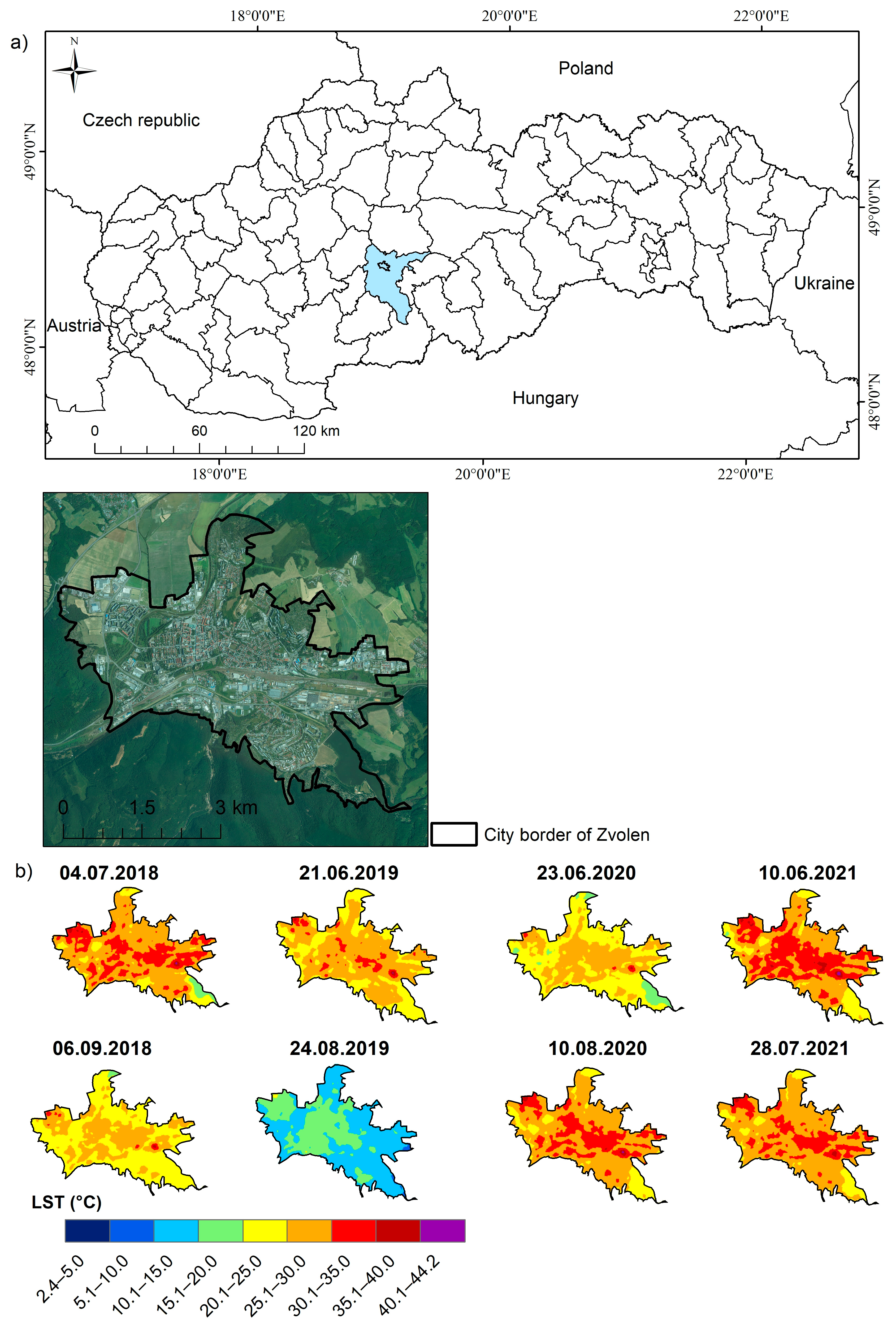
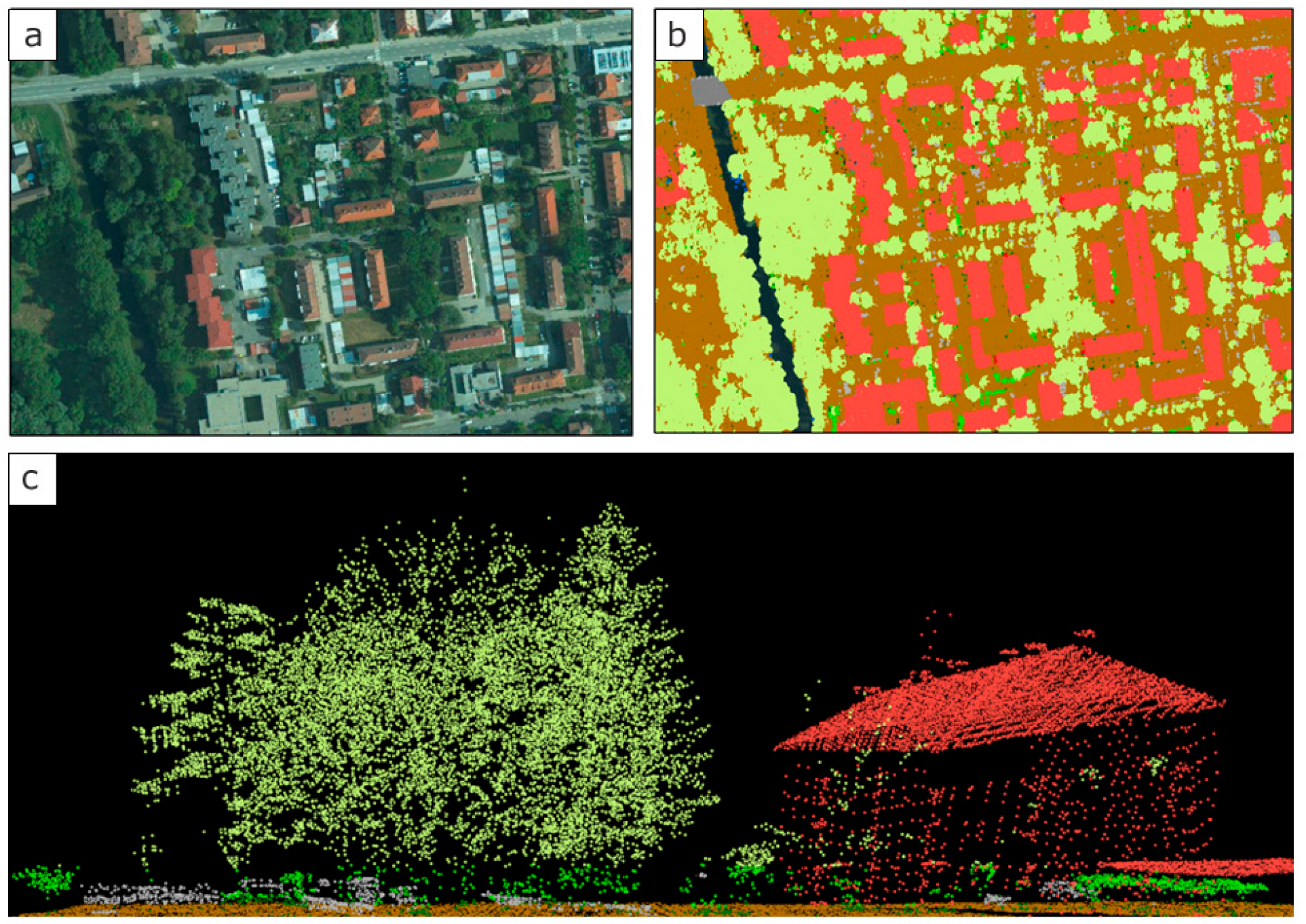
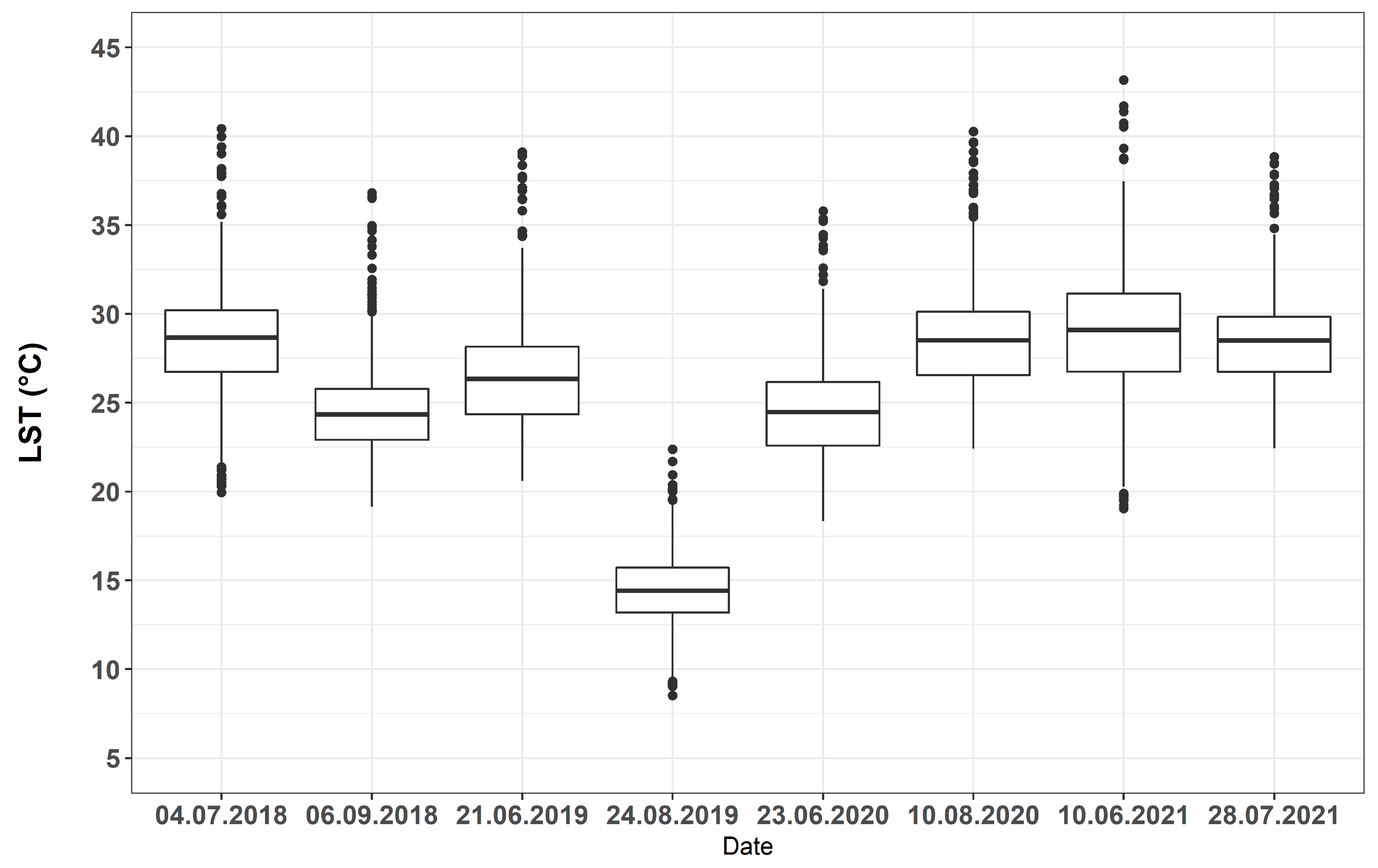

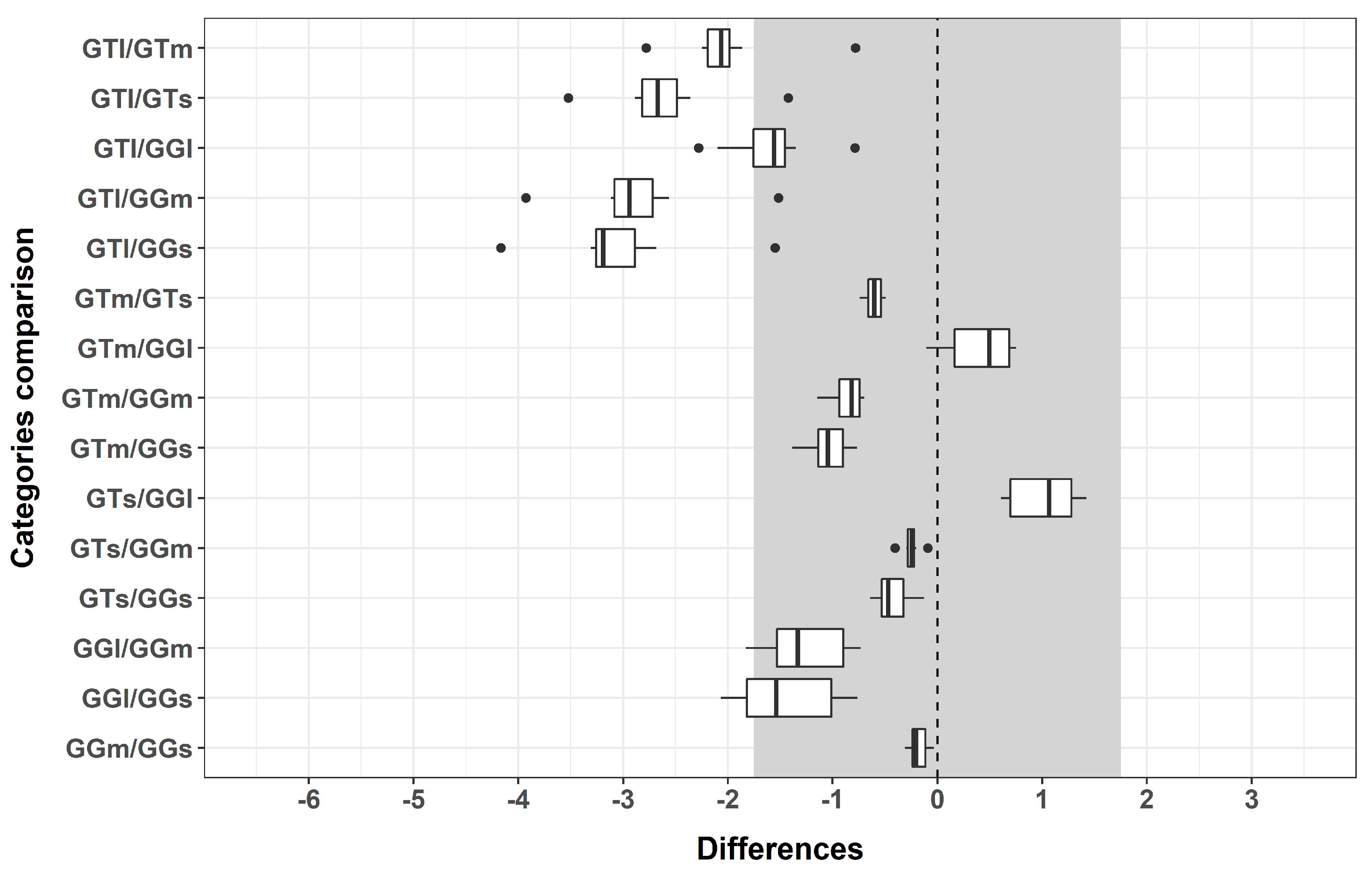
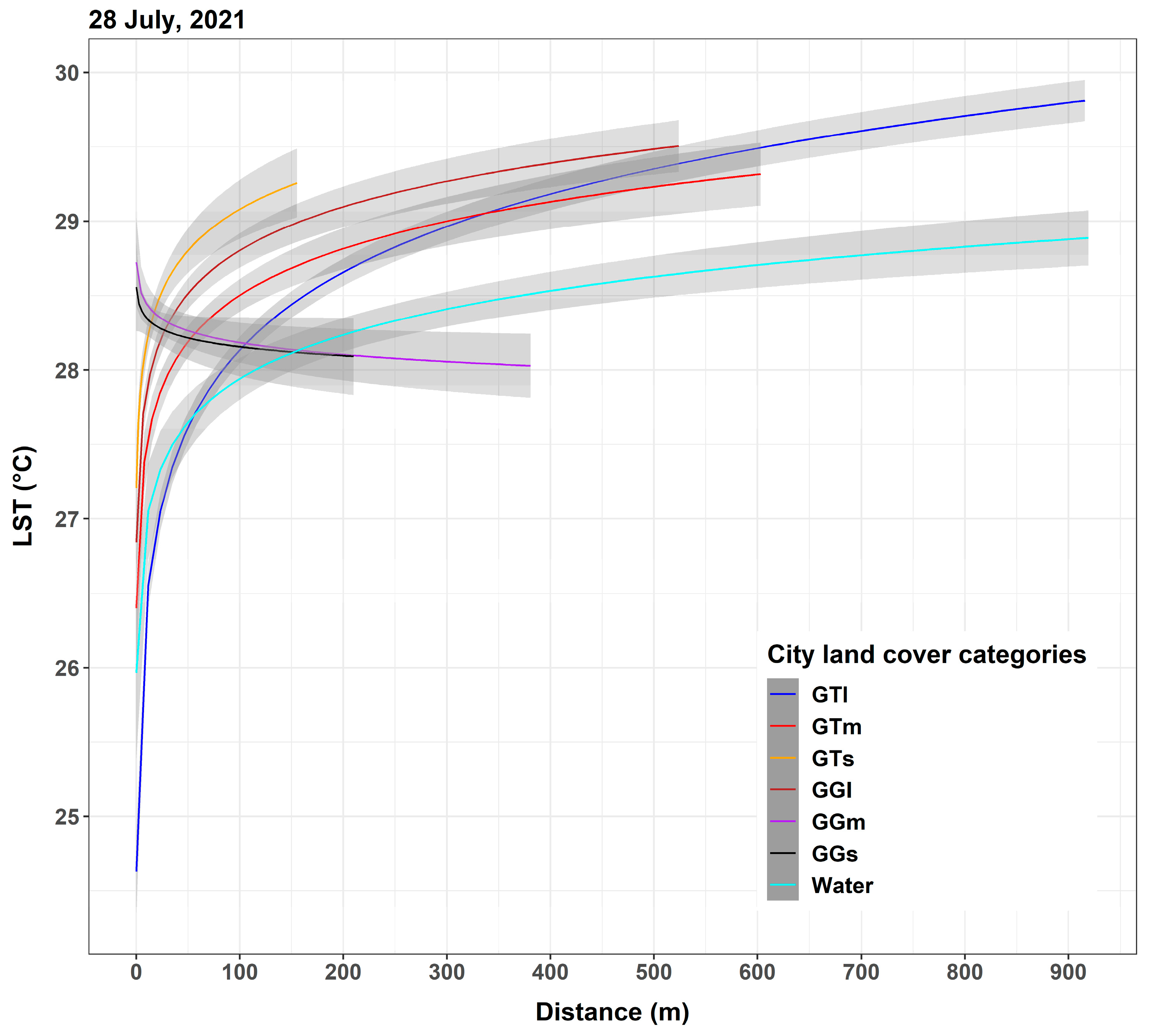


| Date of Accusations | Satellite | Band Used | Sensor | Resolution | Time (GMT) | Local Time (GMT+1) |
|---|---|---|---|---|---|---|
| 04.07.2018 | Landsat-8 | Band 10 | OLI/TIRS | 30/100 | 09:31 | 10:31 |
| 06.09.2018 | Landsat-8 | Band 10 | OLI/TIRS | 30/100 | 09:32 | 10:32 |
| 21.06.2019 | Landsat-8 | Band 10 | OLI/TIRS | 30/100 | 09:32 | 10:32 |
| 24.08.2019 | Landsat-8 | Band 10 | OLI/TIRS | 30/100 | 09:33 | 10:33 |
| 23.06.2020 | Landsat-8 | Band 10 | OLI/TIRS | 30/100 | 09:32 | 10:32 |
| 10.08.2020 | Landsat-8 | Band 10 | OLI/TIRS | 30/100 | 09:32 | 10:32 |
| 10.06.2021 | Landsat-8 | Band 10 | OLI/TIRS | 30/100 | 09:32 | 10:32 |
| 28.07.2021 | Landsat-8 | Band 10 | OLI/TIRS | 30/100 | 09:32 | 10:32 |
| Category of City Land Cover | Area (ha) | % |
|---|---|---|
| GGs—Green Grass small spaces up to 1000 m2 | 120.3 | 6.9 |
| GGm—Green Grass medium spaces 1000–10,000 m2 | 127.2 | 7.3 |
| GGl—Green Grass large spaces over 10,000 m2 | 281.8 | 16.1 |
| GTs—Green Tree small spaces up to 1000 m2 | 132.9 | 7.6 |
| GTm—Green Tree medium spaces 1000–10,000 m2 | 81.5 | 4.7 |
| GTl—Green Tree large spaces over 10,000 m2 | 118.9 | 6.8 |
| Us—Urban small areas without vegetation up to 10,000 m2 | 64.1 | 3.7 |
| Ul—Urban large areas without vegetation over 10,000 m2 | 613.1 | 35.0 |
| Arable land | 54.7 | 3.1 |
| Water (rivers and reservoirs) | 157.3 | 9.0 |
| Total | 1751.8 | 100.0 |
| Categories of City Land Cover (Max Distance) | 4 July 2018 | 6 September 2018 | ||||||||
| p | Radj2 | Intrc | Slope (bt Slope) | SE | p | Radj2 | Intrc | Slope (bt Slope) | SE | |
| GTl (915.9 m) | <10−4 | 0.289 | 24.34 | 0.847 (0.00092) | 0.024 | <10−4 | 0.317 | 20.84 | 0.730 (0.00080) | 0.020 |
| GTm (603.1 m) | <10−4 | 0.075 | 26.01 | 0.579 (0.00096) | 0.037 | <10−4 | 0.069 | 22.46 | 0.456 (0.00076) | 0.031 |
| GTs (155.2 m) | <10−4 | 0.056 | 27.02 | 0.521 (0.00336) | 0.039 | <10−4 | 0.047 | 23.31 | 0.392 (0.00253) | 0.032 |
| GGl (524.0 m) | <10−4 | 0.070 | 27.22 | 0.353 (0.00067) | 0.024 | <10−4 | 0.112 | 23.11 | 0.367 (0.00070) | 0.019 |
| GGm (380.9 m) | 0.013 | 0.002 | 28.75 | −0.088 (−0.00023) | 0.035 | 0.003 | 0.003 | 24.68 | −0.087 (−0.00023) | 0.029 |
| GGs (210.0 m) | 0.776 | – | – | – | – | 0.136 | – | – | – | – |
| Water (1838.5 m) | <10−4 | 0.022 | 26.5 | 0.346 (0.00019) | 0.042 | <10−4 | 0.015 | 23.09 | 0.230 (0.00013) | 0.034 |
| Categories of City Land Cover (Max Distance) | 21 June 2019 | 24 August 2019 | ||||||||
| p | Radj2 | Intrc | Slope (bt Slope) | SE | p | Radj2 | Intrc | Slope (bt Slope) | SE | |
| GTl (915.9 m) | <10−4 | 0.307 | 22.18 | 0.856 (0.00093) | 0.024 | <10−4 | 0.173 | 12.23 | 0.463 (0.00051) | 0.019 |
| GTm (603.1 m) | <10−4 | 0.056 | 24.27 | 0.489 (0.00081) | 0.037 | <10−4 | 0.046 | 13.12 | 0.322 (0.00053) | 0.027 |
| GTs (155.2 m) | <10−4 | 0.038 | 25.18 | 0.420 (0.00271) | 0.039 | <10−4 | 0.013 | 13.99 | 0.177 (0.00114) | 0.028 |
| GGl (524.0 m) | <10−4 | 0.193 | 24.34 | 0.576 (0.00110) | 0.022 | <10−4 | 0.087 | 13.52 | 0.278 (0.00053) | 0.017 |
| GGm (380.9 m) | <10−4 | 0.007 | 26.89 | −0.159 (−0.00042) | 0.034 | 0.052 | – | – | – | – |
| GGs (210.0 m) | <10−4 | 0.007 | 26.87 | −0.189 (−0.00090) | 0.042 | <10−4 | 0.005 | 14.82 | −0.122 (−0.00058) | 0.030 |
| Water (1838.5 m) | <10−4 | 0.025 | 24.32 | 0.359 (0.00020) | 0.041 | <10−4 | 0.022 | 13.11 | 0.245 (0.00013) | 0.029 |
| Categories of City Land Cover (Max Distance) | 23 June 2020 | 10 August 2020 | ||||||||
| p | Radj2 | Intrc | Slope (bt Slope) | SE | p | Radj2 | Intrc | Slope (bt Slope) | SE | |
| GTl (915.9 m) | <10−4 | 0.277 | 20.62 | 0.780 (0.00085) | 0.023 | <10−4 | 0.309 | 24.27 | 0.852 (0.00093) | 0.023 |
| GTm (603.1 m) | <10−4 | 0.051 | 22.52 | 0.448 (0.00074) | 0.035 | <10−4 | 0.068 | 26.15 | 0.537 (0.00089) | 0.036 |
| GTs (155.2 m) | <10−4 | 0.034 | 23.36 | 0.386 (0.00249) | 0.037 | <10−4 | 0.041 | 27.22 | 0.436 (0.00281) | 0.038 |
| GGl (524.0 m) | <10−4 | 0.189 | 22.52 | 0.545 (0.00104) | 0.021 | <10−4 | 0.170 | 26.55 | 0.535 (0.00102) | 0.022 |
| GGm (380.9 m) | <10−4 | 0.006 | 24.93 | −0.148 (−0.00039) | 0.033 | <10−4 | 0.006 | 28.91 | −0.143 (−0.00038) | 0.034 |
| GGs (210.0 m) | <10−4 | 0.008 | 24.98 | −0.200 (−0.00095) | 0.040 | <10−4 | 0.005 | 28.87 | −0.164 (−0.00078) | 0.041 |
| Water (1838.5 m) | <10−4 | 0.014 | 22.99 | 0.253 (0.00014) | 0.039 | <10−4 | 0.026 | 26.39 | 0.359 (0.00020) | 0.040 |
| Categories of City Land Cover (Max Distance) | 10 June 2021 | 28 July 2021 | ||||||||
| p | Radj2 | Intrc | Slope (bt Slope) | SE | p | Radj2 | Intrc | Slope (bt Slope) | SE | |
| GTl (915.9 m) | <10−4 | 0.316 | 23.7 | 1.076 (0.00117) | 0.029 | <10−4 | 0.307 | 24.63 | 0.760 (0.00083) | 0.021 |
| GTm (603.1 m) | <10−4 | 0.048 | 26.55 | 0.564 (0.00094) | 0.046 | <10−4 | 0.061 | 26.4 | 0.456 (0.00076) | 0.033 |
| GTs (155.2 m) | <10−4 | 0.031 | 27.63 | 0.475 (0.00306) | 0.048 | <10−4 | 0.045 | 27.21 | 0.406 (0.00262) | 0.034 |
| GGl (524.0 m) | <10−4 | 0.159 | 26.68 | 0.647 (0.00123) | 0.027 | <10−4 | 0.134 | 26.84 | 0.425 (0.00081) | 0.020 |
| GGm (380.9 m) | <10−4 | 0.010 | 29.73 | −0.231 (−0.00061) | 0.042 | <10−4 | 0.005 | 28.72 | −0.117 (−0.00031) | 0.030 |
| GGs (210.0 m) | <10−4 | 0.004 | 29.43 | −0.179 (−0.00085) | 0.051 | 0.019 | 0.002 | 28.56 | −0.087 (−0.00041) | 0.037 |
| Water (1838.5 m) | <10−4 | 0.004 | 27.89 | 0.183 (0.00010) | 0.051 | <10−4 | 0.034 | 26.26 | 0.368 (0.00020) | 0.036 |
Disclaimer/Publisher’s Note: The statements, opinions and data contained in all publications are solely those of the individual author(s) and contributor(s) and not of MDPI and/or the editor(s). MDPI and/or the editor(s) disclaim responsibility for any injury to people or property resulting from any ideas, methods, instructions or products referred to in the content. |
© 2023 by the authors. Licensee MDPI, Basel, Switzerland. This article is an open access article distributed under the terms and conditions of the Creative Commons Attribution (CC BY) license (https://creativecommons.org/licenses/by/4.0/).
Share and Cite
Gallay, I.; Olah, B.; Murtinová, V.; Gallayová, Z. Quantification of the Cooling Effect and Cooling Distance of Urban Green Spaces Based on Their Vegetation Structure and Size as a Basis for Management Tools for Mitigating Urban Climate. Sustainability 2023, 15, 3705. https://doi.org/10.3390/su15043705
Gallay I, Olah B, Murtinová V, Gallayová Z. Quantification of the Cooling Effect and Cooling Distance of Urban Green Spaces Based on Their Vegetation Structure and Size as a Basis for Management Tools for Mitigating Urban Climate. Sustainability. 2023; 15(4):3705. https://doi.org/10.3390/su15043705
Chicago/Turabian StyleGallay, Igor, Branislav Olah, Veronika Murtinová, and Zuzana Gallayová. 2023. "Quantification of the Cooling Effect and Cooling Distance of Urban Green Spaces Based on Their Vegetation Structure and Size as a Basis for Management Tools for Mitigating Urban Climate" Sustainability 15, no. 4: 3705. https://doi.org/10.3390/su15043705
APA StyleGallay, I., Olah, B., Murtinová, V., & Gallayová, Z. (2023). Quantification of the Cooling Effect and Cooling Distance of Urban Green Spaces Based on Their Vegetation Structure and Size as a Basis for Management Tools for Mitigating Urban Climate. Sustainability, 15(4), 3705. https://doi.org/10.3390/su15043705









